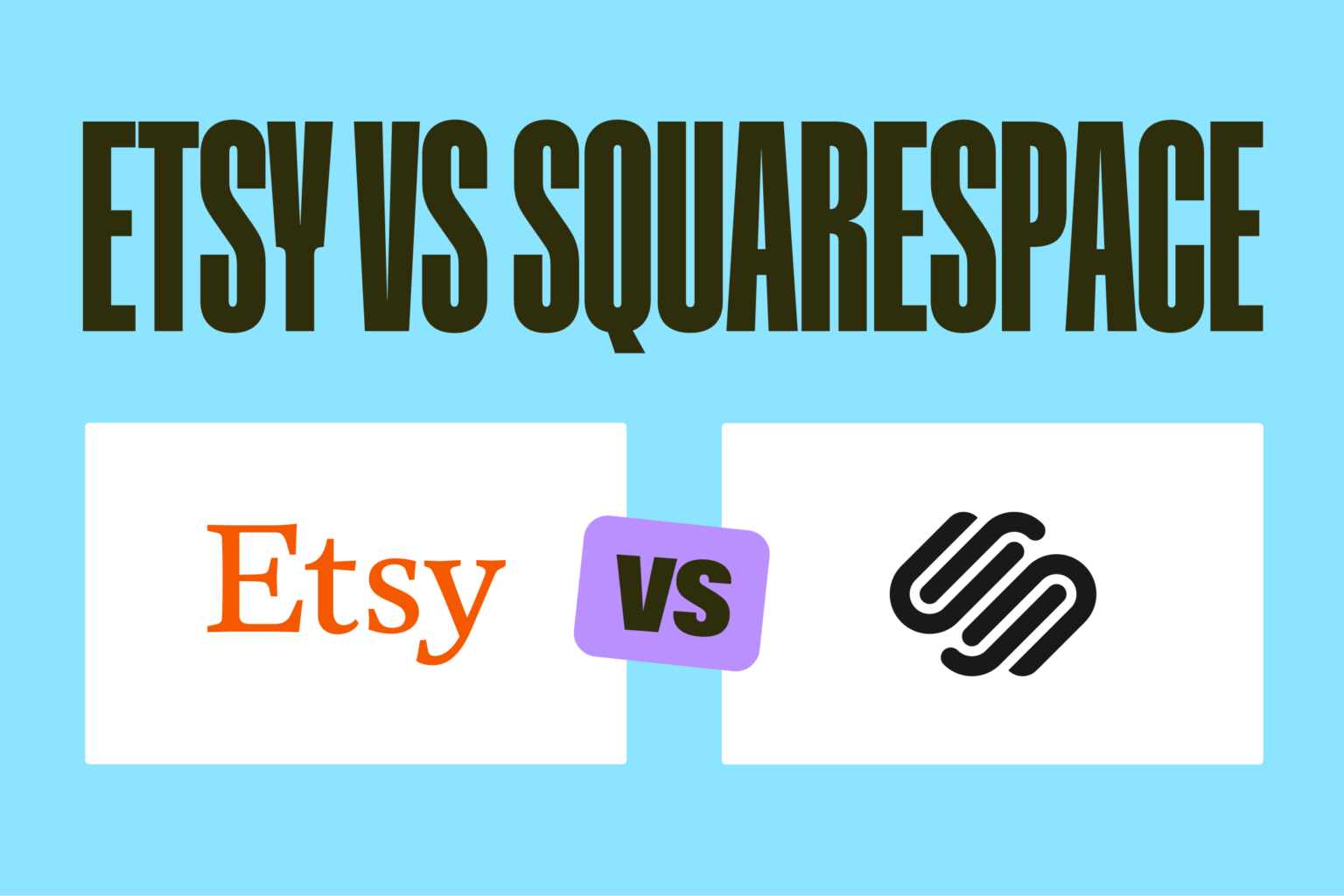Sell custom products with Printify
Etsy and Squarespace are two powerful platforms for selling handcrafted items, digital products, and more. Understanding the differences between Etsy, a popular online marketplace, and Squarespace, a well-known platform for creating your own website, can help you make the best decision for your online store.
This guide dives into Etsy and Squarespace’s key features, pros, cons, and capabilities. We’ll compare pricing, customization, usability, marketing solutions, and advanced features to help you decide between each eCommerce platform.
Etsy vs Squarespace: Overview
Etsy
Etsy is a leading online marketplace for creators and sellers of handmade or vintage products. With millions of active buyers and a user-friendly interface, Etsy has become a go-to eCommerce platform for small online businesses.
Features and benefits:
- Ease of use: Setting up an Etsy store is quick and straightforward – list your products in just a few clicks. This will save you time and allow you to focus on growing your business.
- Global reach: Etsy connects sellers to an international audience, allowing you to expand your market beyond local customers and tap into global sales opportunities.
- Established marketplace: Leverage Etsy’s reputation as a trustworthy platform to drive more sales and gain visibility for your products.
- Marketing tools: Etsy offers built-in marketing tools, such as promoted listings, discount coupons, and email campaigns. Use these tools to easily promote your store and attract more customers, increasing your sales potential.
Pros and cons of Etsy:
| Pros | Cons |
|---|---|
| User-friendly seller dashboard | Pricing competition can reduce profits |
| International audience | High transaction and listing fees |
| Built-in marketing tools | Dependency on Etsy’s infrastructure |
| Established eCommerce platform | Limited customization |
| Community-oriented platform | Less comprehensive analytics |
Squarespace
Squarespace is a versatile website-building platform that also functions as an eCommerce platform, allowing sellers to create fully customizable online stores. Squarespace offers sleek designs and convenient features for those looking to establish their own brand and maintain full control over their eCommerce business.
Features and benefits:
- Customizable templates: Squarespace offers many design options, allowing you to build a unique Squarespace store that reflects your brand.
- Built-in SEO tools: Optimize your site for search engines with keyword management and sitemap generation tools, helping improve visibility.
- Advanced eCommerce features: Squarespace supports digital downloads, subscription services, and multiple payment gateways to meet diverse customer needs.
- Comprehensive analytics: Gain insights into customer behavior and sales performance to make data-driven decisions and drive growth.
Pros and cons of using Squarespace:
| Pros | Cons |
|---|---|
| Stunning designs and templates | Dependency on Squarespace hosting |
| Built-in SEO tools | Transaction fees on certain plans |
| Excellent customer support | Page speed may be slower compared to competitors |
| Comprehensive analytics | Website editor usability has a learning curve |
| Unlimited bandwidth and storage | Less focus on community compared to Etsy |
| Mobile apps for on-the-go management | Costs can add up with commerce plans |
If you run a small online business selling handmade and vintage products, Etsy provides quick access to a large audience. However, if you want to create a fully branded eCommerce store, Squarespace might be the best option.
Etsy vs Squarespace: Which one is better?
Pricing

Etsy:
Etsy operates on a pay-as-you-go model, with fees tied to listings and transactions:
- Listing fee: Etsy charges $0.20 per item, billed every four months.
- Transaction fees: 6.5% of the selling price.
- Payment processing fees: Etsy charges vary by country (e.g., 3% + $0.25 in the US).
- Optional Etsy Plus premium plan adds more features and marketing credits for $10/month.
Squarespace:
Squarespace provides tiered subscription pricing with different features:
- Personal plan: $16/month, no eCommerce.
- Business plan: $23/month, includes basic eCommerce and 3% transaction fees.
- Commerce plans: $27/month (Basic) and $49/month (Advanced), that eliminate transaction fees and include advanced eCommerce features like subscription plans and customer accounts.
Conclusion: Etsy’s pricing is better for sellers looking to minimize upfront costs, whereas Squarespace Commerce offers more comprehensive features at a fixed monthly rate, particularly on higher-tier plans.
Branding and customization

Etsy:
Etsy limits your ability to build a fully unique brand. While you can personalize your Etsy shop’s banner, logo, and product descriptions, the overall design of your own store depends on Etsy’s platform.
If you want more tools and customization options to improve shop visibility and branding, Etsy offers a separate solution called Etsy Plus.
Squarespace:
Squarespace gives you full control over your shop layout through customizable templates, allowing you to create a visually distinct Squarespace store. To improve branding, use social media integration, search engine optimization tools, and comprehensive features such as embedded videos.
Conclusion: Etsy focuses on consistency across the marketplace, whereas Squarespace allows you to build your own domain and fully branded store.
Ease of use
Etsy:
Etsy’s intuitive dashboard simplifies managing listings, orders, and customer interactions. With built-in tools for marketing, analytics, and fulfillment, sellers can easily track performance and grow their shop.
Squarespace:
Squarespace’s website editor has more advanced features but a steeper learning curve. However, the platform’s drag-and-drop interface makes customization simple once you get the hang of it.
Conclusion: Etsy is easier for beginners, but Squarespace, a popular site builder, caters to users who want more control over the design and functionality of their store.
Marketing tools
Etsy:
Etsy has built-in tools for promotions, sales, and email marketing to Etsy customers. Additional features include Etsy Ads and integration with Google Shopping, making it easier to reach a large audience.
Squarespace:
Squarespace comes with strong marketing tools for SEO, email campaigns, and social media scheduling. The platform’s blog feature helps you drive traffic through content marketing, and its analytics provide insights for campaign optimization.
Conclusion: Both Squarespace and Etsy platforms offer powerful tools for marketing, but Squarespace provides more advanced eCommerce features for sellers seeking long-term growth.
eCommerce features
Etsy:
Etsy is a reliable choice for selling handcrafted products, vintage items, and craft supplies. Its intuitive interface allows sellers to set up their online store quickly, offering a streamlined approach to reaching a worldwide audience.
However, Etsy’s eCommerce capabilities are primarily focused on physical goods, with limited support for those looking to sell virtual products such as eBooks or templates. It also doesn’t have subscriptions or advanced product bundling options, which may limit growth for sellers exploring multiple sales channels.
Etsy’s free-to-join model is appealing to new sellers, but you’ll face costs like listing fees, transaction fees, and payment processing charges as your store grows. While Etsy is a great starting point, it offers less flexibility for sellers looking for more control over their eCommerce operations.
Squarespace:
Squarespace is a feature-packed platform for sellers who want to easily create a professional online store and sell digital products. Its eCommerce platform supports features like digital downloads, recurring memberships, and subscription-based products.
Unlike Etsy, Squarespace allows you to sell an unlimited number of products, including physical items and digital content such as videos, artwork, or templates.
For sellers using multiple sales channels, Squarespace integrates seamlessly with payment gateways like Stripe, PayPal, and Apple Pay, offering flexible payment administration options.
While Squarespace doesn’t offer a free plan, its tiered pricing ensures that higher-tier plans include tools such as SEO, abandoned cart recovery, and inventory management. This makes Squarespace a more flexible option for growing businesses that require a more comprehensive platform.
Conclusion: Etsy is best for marketplace selling, but Squarespace is better for sellers who require more advanced features to grow an independent eCommerce store.
Customer support

Etsy:
Etsy offers customer support via email, live chat, and community forums. The platform’s community-oriented approach encourages interaction among Etsy store owners by providing a space to share tips and resolve common issues. However, due to high inquiry volumes, live support availability may vary at peak times.
Squarespace:
Squarespace makes customer support seamless with 24/7 availability via email and live chat. The platform also provides an extensive knowledge base and training materials, allowing users to troubleshoot problems on their own.
Its extensive resources and consistent availability give it a competitive advantage.
Conclusion: While Etsy’s community-oriented forums can be valuable for collaborative problem-solving, Squarespace makes customer support more reliable with its 24/7 availability and self-help resources.
Tips for successfully selling on Squarespace vs Etsy
Whether you run an Etsy shop or a Squarespace store, success depends on optimizing your storefront and using the tools available. Here are some tips to help you thrive on both platforms.
Tips for Etsy
Selling on Etsy allows you to reach a large customer base, but standing out requires strategy. Here’s how to make the most of the Etsy marketplace:
- Build your brand:
- Create a cohesive shop layout with a professional logo, banner, and product photography reflecting your brand.
- Set goals:
- Define clear sales targets to track progress and align your efforts with long-term growth.
- Keywords:
- Use relevant keywords like “handmade products” and “vintage items” in product titles and descriptions to improve search visibility on Etsy.
- Optimize listings:
- Write detailed product descriptions that include all available photos and highlight key benefits.
- Participate in the community:
- Join Etsy forums or local teams to network, gain insights, and promote your store.
Tips for Squarespace
Building a store that drives traffic and sales means taking full advantage of Squarespace’s eCommerce features.
- Keywords:
- Use SEO strategies to target terms like “digital products” or “custom website design” for better search rankings.
- Customize design:
- Use Squarespace’s photo styles, templates, and shop design options to create a unique website reflecting your brand.
- Optimize for mobile:
- Ensure your site is mobile-friendly for customers shopping on smartphones or tablets.
- Use SEO tools:
- Use built-in SEO tools to enhance your website, including meta descriptions, alt text for images, and sitemap generation.
- Monitor analytics:
- Use Squarespace’s in-depth training materials and analytics tools to better understand customer behavior and refine your strategy.
Following these tips will help you maximize the potential of both platforms, whether you’re targeting a loyal Etsy customer base or creating a unique Squarespace commerce experience.
FAQ
It all depends on your business goals. Etsy is perfect for small businesses selling handcrafted products and vintage items because of its established online marketplace and large customer base.
However, creating your own website using a platform like Squarespace gives you more control over branding, design, and customer relationships. If you prioritize simplicity and a built-in audience, Etsy is a great choice. If you want to build a fully customized and branded experience, a Squarespace store may be better.
Yes! It’s great if you want a customizable, feature-packed platform for your online store. Squarespace’s eCommerce platform supports subscriptions and many advanced eCommerce features like organic search tools and analytics.
It’s especially valuable for sellers who want to establish their independent domain and control the full shopping experience. However, attracting customers may require more effort than using Etsy’s built-in audience.
Squarespace supports multiple payment gateways, including Stripe, PayPal, and Apple Pay, giving sellers flexibility in handling transactions. Etsy, on the other hand, uses Etsy Payments, which simplifies payment processing but limits options. While both platforms offer secure payment methods, Squarespace provides a wider range of options, especially for businesses with varied needs.
Final verdict: Squarespace vs Etsy
The decision comes down to your business objectives and the type of online store you want to create. Both Etsy and Squarespace offer different benefits that address various seller needs.
- Etsy is perfect for small online businesses and artisans looking to sell handcrafted or vintage products. It gives you access to a large, ready-made audience and is simple to use, making it ideal for beginners or those interested in community-driven sales.
- Squarespace is a multifunctional platform for building a fully customized eCommerce store. Its premium features – such as subscription options, digital downloads, and robust tools for SEO – make it a great choice for sellers who want more control over their branding and customer experience.
Are you ready to sell online? Explore Etsy to reach a global audience, or create a Squarespace store for a completely customized brand experience. Whichever platform you choose, the key is to take action and start turning your passion into profit today!












